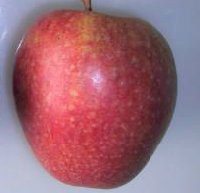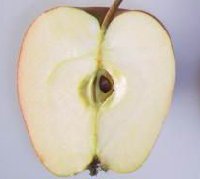PARENTAGE
The parentage of this variety is not known but there is strong evidence that it originates from Herefordshire. It is named after the gardener who presented it to the Horticultural Society in 1826 which indicates it has been cultivated many years before that date.
APPEARANCE, TASTE AND CHARACTERISTICS OF ADAM’S PEARMAIN APPLE
The fruit is on the large side and has the classic Pearmain shape with the top of the apple being wider than the bottom. The russeting appears on the shaded side of the apple and is not particularly pronounced.
The side exposed to the sun is mainly red and yellow with green streaks whilst the side not exposed to the sun is mainly yellow. The picture below shows the side of the apple exposed to the sun. The tree produces lots of fruit when established and has good disease resistance especially to apple scab.

Texture is crisp with the flesh dense but juicy and a light yellow colour. The taste is a good balance of acidity and sweetness with a very pleasant real apple aroma, this is a desert (eating apple). Fruit is ripe in mid October and will keep for a couple of months.
Adam’s Pearmain is in pollination group 3 and is self-sterile so it needs a suitable pollination partner nearby (see below). It is not a good pollinator for other apple trees.

ADAMS PEARMAIN FLOWERING AND HARVEST TIMES:
The average flowering time (optimum time for pollination) and date when fruits are ripe in the UK for the Adam’s Pearmain apple tree are set out below. If you have set your home town we can give you a more accurate estimate, if you have not set your home town (do it now by clicking here) the dates below will be the average for the UK. Your town has not been set, the average main flowering time for Adams Pearmain in the UK is the first week of May. Fruit will be ready for harvesting in the second week of October. Click here if you want to set the dates to your home town.
Flowering and fruit picking dates vary according to the weather in any particular growing season so the above dates may well change slightly from one year to the next. The flowering date above is when the apple tree produces the maximum number of blossoms, it will also produce blossom, although less, a week or two either side of the date given. Even though flowering times may differ from year to year depending on conditions it will, in general, do the same for all apple varieties.
BUYING AN ADAM’S PEARMAIN APPLE TREE
Adam’s Pearmain apple trees are not normally found at garden centres although they are reasonably common online. So your choices for sourcing this apple tree are either from online websites or specialist nurseries. Remember that all apple trees need a stake to support them for the first couple of years and some require staking for life. So if you haven’t got a stake and a tie for your new tree then buy one when you order the tree for convenience.
COMMON POLLINATION PARTNERS FOR ADAMS PEARMAIN
Adams Pearmain is in pollination group 3, self-sterile and needs a pollination partner. Suitable pollination varieties include the following:
- Alkmene – pollination group 2, self-sterile, eater
- Arthur Turner – pollination group 3, self-sterile, cooker
- Beauty of Bath – pollination group 2, self-sterile, eater
- Bountiful – pollination group 3, self-sterile, cooker
- Braeburn – pollination group 4, self-fertile, eater
- Charles Ross – pollination group 3, partially self-fertile, cooker and eater
- Court of Wick – pollination group 3, self-sterile, eater and cooker
- Devonshire Quarrenden – pollination group 2, partially self-fertile, cooker
- Discovery – pollination group 3, self-sterile, eating and cider
- Dumelows Seedling – pollination group 4, self-sterile, cooker
- Egremont Russet – pollination group 2, partially self-fertile, eater and cooker
- Ellisons Orange – pollination group 4, partially self-fertile, eater
- Falstaff – pollination group 3, self-fertile, eater
- Fiesta – pollination group 3, partially self-fertile, eater
- Gala – pollination group 4, partially self-fertile, eater
- Golden Delicious – pollination group 4, partially self-fertile, eater and cooker
- Granny Smith – pollination group 3, self-fertile, eater and cooker
- Greensleeves – pollination group 2, self-fertile, eater, cooker, juice
- Grenadier – pollination group 3, partially self-fertile, cooker
- Honeycrisp – pollination group 4, self-sterile, eater
- Howgate Wonder – pollination group 3, partially self-fertile, cooker and eater
- Idared – pollination group 2, self-sterile, eater
- James Grieve – pollination group 3, partially self-fertile, cooker and eater
- Katy – pollination group 3, self-sterile, both
- Kidds Orange Red – pollination group 3, self-sterile, eater
- King of The Pippins – pollination group 4, self-fertile, eater and cooker
- Lanes Prince Albert – pollination group 4, self-sterile, cooking
- Laxtons Fortune – pollination group 3, partially self-fertile, eater
- Laxtons Superb – pollination group 4, partially self-fertile, eater
- Lord Derby – pollination group 4, self-sterile, cooker
- Lord Lambourne – pollination group 2, self-fertile, eater and cooker
- Newton Wonder – pollination group 4, partially self-fertile, cooker
- Peasgoods Nonsuch – pollination group 3, partially self-fertile, cooker
- Rajka – pollination group 4, self-sterile, eater
- Red Falstaff – pollination group 3, self-fertile, eater
- Red Windsor – pollination group 2, self-fertile, eater
- Reverend W Wilks – pollination group 2, self-fertile, cooker
- Scrumptious – pollination group 3, self-fertile, eater
- Sops in Wine – pollination group 3, self-sterile, eater
- Spartan – pollination group 3, self-fertile, eater
- Sunset – pollination group 3, self-fertile, eater
- Tydemans Late Orange – pollination group 4, self-sterile, eater
- Waltz – pollination group 3, self-sterile, eater
- Winston – pollination group 4, self-fertile, eater
- Worcester Pearmain – pollination group 3, partially self-fertile, eater
SUMMARY CHARACTERISTICS OF ADAMS PEARMAIN
USE: Eating
SKIN COLOUR / TEXTURE: Red with yellow areas
FLESH COLOUR: Light yellow
TASTE AND TEXTURE: Acid and sweet with an excellent apple aroma, crisp, dense and crunchy
FRUIT SIZE: Slightly larger than average
STORAGE: Two months
SUITABILITY FOR CORDON / ESPALIER GROWTH: Not known
TREE SIZE: Slight below average size depending on rootstock and conditions
REGULARITY OF CROPPING: Regular
POLLINATION: Group 3, self sterile, needs a suitable pollination partner. Not good at pollinating other varieties
AWARDS: None
SPECIAL FEATURES: Very pleasant tasting apple, dates back to 1826. The full list of apple tree varieties which we have reviewed is listed below. Select any one of them and then click the “More Information” button to be taken to the in depth review:
Rootstocks and Size
Guide to Planting
Care Plan
Pruning Apple Trees
Harvest and Storage
Pests and Disease
Pollination Groups
ADAM’S PEARMAIN APPLE TREE
The parentage of Adam’s Pearmain is not known because it dates back at least to 1826 and probably earlier. It is an old English apple with a classic pearmain shape (wider at the top than it is at the bottom).
The apple skin is partially russeted and the remainder of the skin is orange, yellow and red. The taste is quoted as being “crisp, juicy, rich and sugary with an agreeable and pleasantly perfumed flavour”.
The shape, taste, flavour and colour identify this apple tree as well as its long thin shoots which benefit from light summer pruning.